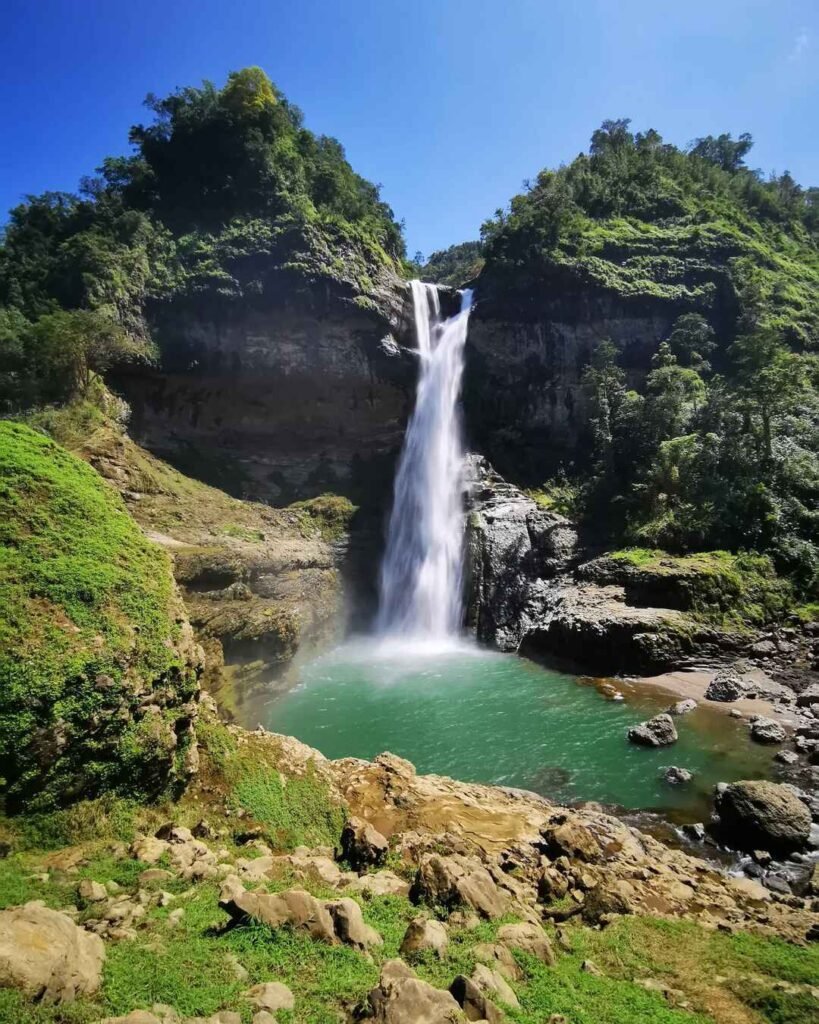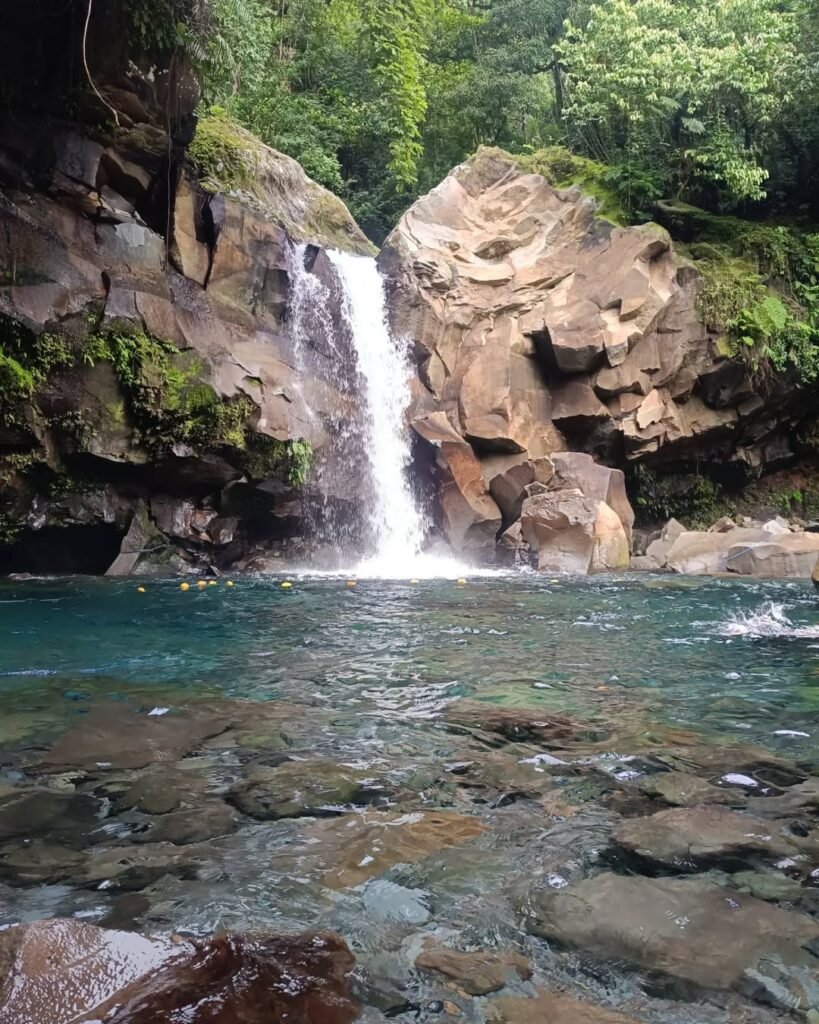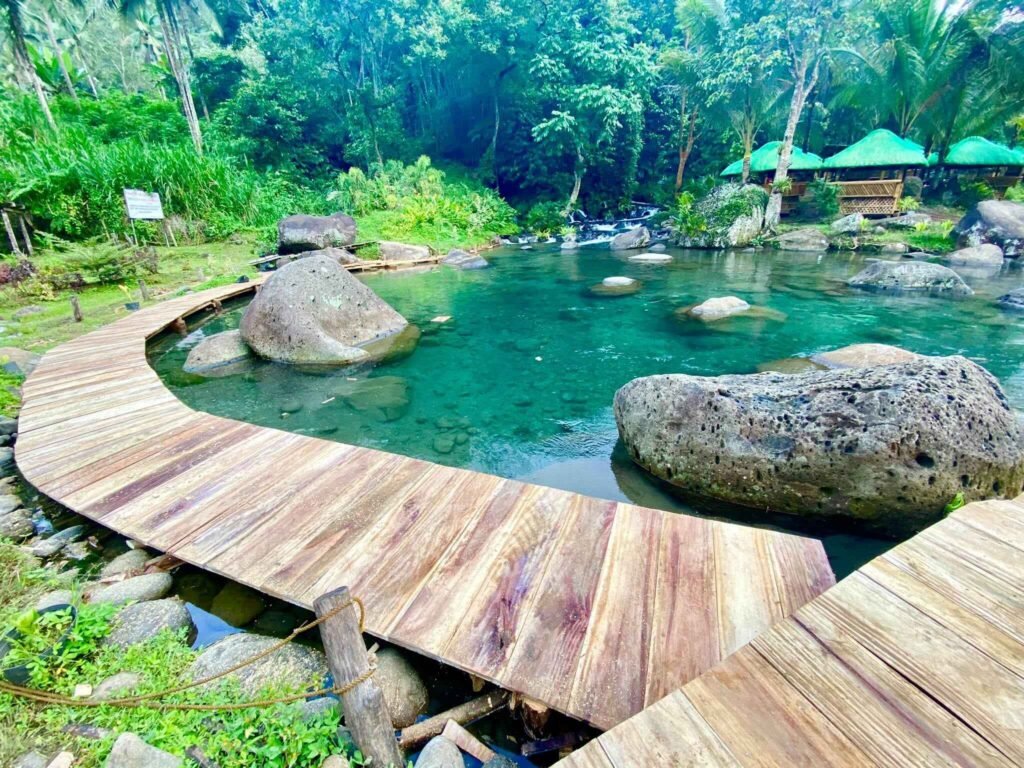
Introduction: The Allure of Sinulom Falls
The first time I laid eyes on Sinulom Falls, I was instantly captivated by its grandeur. Imagine standing before a massive rock wall where 27 to 28 waterfalls cascade side by side, forming what looks like a shimmering curtain of water. The sound of rushing streams blending together creates a natural symphony, while the mist rising from the falls cools the air around you. It’s the kind of sight that makes you stop in your tracks, breathe deeply, and simply take it all in. Few natural attractions in the region deliver this kind of sensory experience, which is why Sinulom Falls CDO has become one of the most talked-about destinations in Northern Mindanao.
Located just outside the bustling city proper, this wonder flows directly into the mighty Cagayan de Oro River, adding not only to its visual charm but also to its ecological importance. It’s easy to see why it’s trending in local tourism circles. Over the past few years, it has steadily gained traction as both a weekend getaway for locals and a must-see stop for travelers exploring the region. Unlike commercialized parks, Sinulom Falls Philippines strikes a delicate balance between accessibility and raw, untouched beauty.
What sets this destination apart is how compelling it looks even in pictures. A quick glance at Sinulom Falls photos online is usually enough to spark curiosity, with many travelers immediately adding it to their itineraries after seeing the iconic curtain-like cascades. But nothing compares to witnessing it in person—the depth of its history, the freshness of its waters, and the serenity of its setting make it an experience that photographs alone cannot fully capture.
In many ways, visiting Sinulom is about more than chasing waterfalls; it’s about immersing yourself in a place where nature and community intertwine. From its legendary origins during World War II to its rise as a modern-day eco-destination, this waterfall has always been more than just scenery—it’s a lifeline, a retreat, and a reminder of the beauty that thrives just beyond the city.
Table of Contents
The Story of the Falls: History and Origins
Every remarkable destination has a story, and the tale of Sinulom Falls is as fascinating as the cascades themselves. Locals often explain that its name comes from the Visayan word sulom, which means “black ant.” At first, the connection between a majestic waterfall and tiny ants seems puzzling, but the legend behind the name reveals its cultural significance.
The Legend of the Black Ants
According to local elders, during World War II a severe drought plagued the region for nearly nine months. Rivers and wells dried up, leaving communities desperate for water. In the midst of this crisis, villagers discovered a massive rock wall where water continued to flow in abundance. Families hurried to the site, lining up in great numbers to collect the life-saving water. The scene resembled a trail of black ants moving together in search of sustenance—thus, the name “Sinulom” was born. This narrative has since been passed down through generations, making the falls not only a natural wonder but also a symbol of resilience and survival.
Cultural Importance and Lifeline for the Community
Beyond its beauty, the falls played an essential role as a reliable water source during hard times. Its very history demonstrates how nature has provided for the people of Cagayan de Oro and Bukidnon, shaping the area’s identity. For travelers, learning this sinulom falls history adds depth to the experience—visiting becomes more than just sightseeing; it becomes an immersion into local heritage.
Today, when visitors ask “where is Sinulom Falls located?” they are directed to the boundary between Talakag, Bukidnon and Cagayan de Oro City. But more than its geographical spot, what truly matters is how this place remains a reminder of nature’s power to sustain life, even in the darkest of times.
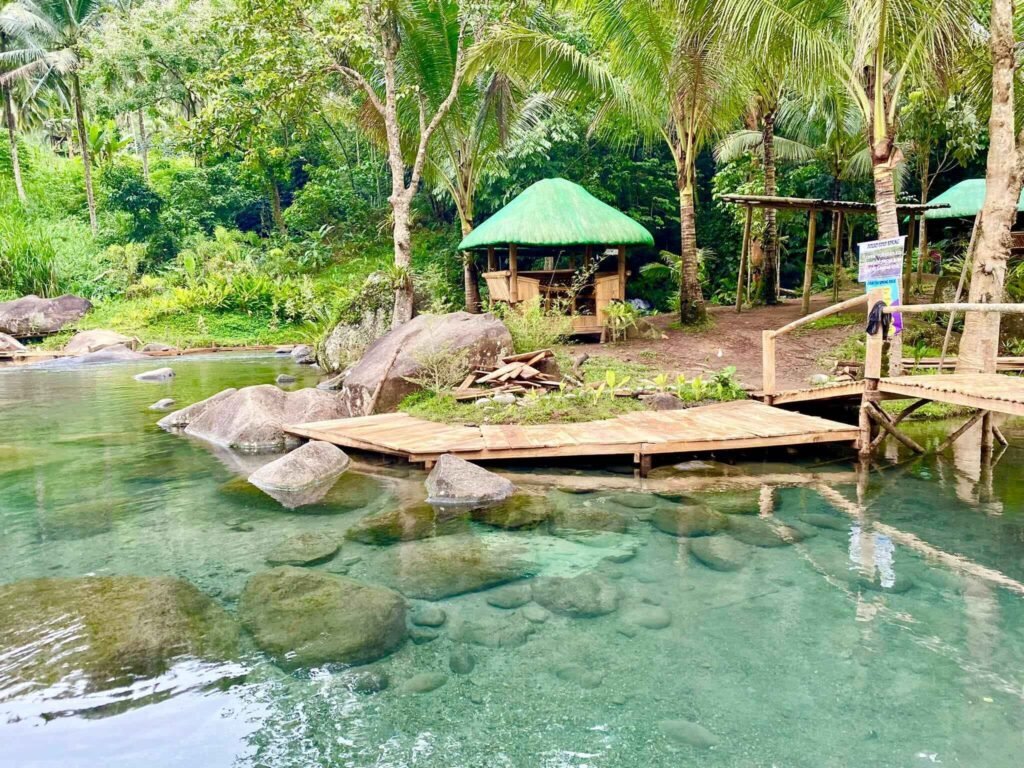
Location and Accessibility
When travelers first ask “where is Sinulom Falls located?” the answer is a little more nuanced than simply pointing to one town. The location of Sinulom Falls actually straddles two provinces—Talakag in Bukidnon and Cagayan de Oro City in Misamis Oriental. Geographically, the waterfalls are installed along the rock walls of Talakag, but the easiest and most commonly used entry point is through Barangay Tignapoloan, CDO. This makes it both a Bukidnon and Cagayan de Oro treasure, depending on which side you approach it from.
For first-time visitors, accessibility is surprisingly convenient. From Cagayan de Oro’s uptown area near SM City CDO, the drive to Barangay Tignapoloan takes about 30 to 45 minutes. From there, travelers continue toward Sitio Impakibel, the jump-off point to the waterfalls. Parking is typically arranged at a local basketball court before visitors proceed on a short trek or a habal-habal ride closer to the site.
For added clarity, I always recommend checking a Sinulom Falls map before your trip. While digital navigation apps are reliable, mobile signal may weaken as you move deeper into the barangay, so downloading an offline map can be handy. Personally, I found that confirming directions with locals at the crossing saved me time and ensured I didn’t miss the small but crucial turns leading to the trailhead.
In short, while the falls are technically rooted in Bukidnon, the most practical way to reach them is via Cagayan de Oro. This dual identity is part of what makes Sinulom Falls CDO such a fascinating and accessible destination—close to the city yet tucked in the lush borders of Bukidnon.
How to Go to Sinulom Falls: Transportation Guide
Figuring out how to go to Sinulom Falls can feel tricky at first, especially since it sits along the boundary of Bukidnon and Cagayan de Oro. But with the right directions, your trip can be both straightforward and enjoyable. Whether you’re driving your own car, renting a motorcycle, or hopping on public transportation, there’s an option that will suit your time, budget, and travel style.
By Private Vehicle or Motorcycle
For those with their own ride—or those renting a motorcycle in the city—the most direct route is via the CDO–Talakag Road. Starting from uptown Cagayan de Oro near SM City CDO, the drive typically takes around 30 to 45 minutes. Along the way, you’ll pass through scenic barangays such as Bayanga, Mambuaya, and Dansolihon.
A key landmark to watch for is the Mangalay Bridge. Once you cross it, you’re only about 800 meters away from the Tignapoloan crossing. Another helpful marker is a small Jehovah’s Witness Kingdom Hall—the turn to Sitio Impakibel is just nearby.
The final stretch can be a mixed bag. Some roads are newly cemented, while others remain rough, steep, and slippery when it rains. Based on my experience, a standard car can handle the trip in the dry season, but during wet months, a 4×4 or a motorcycle with good tires is safer. Parking is available at a dirt basketball court in Sitio Impakibel, and locals often offer to watch vehicles for a small tip. From there, expect a short trek of about two kilometers to reach the falls.
By Public Transportation
If you’re traveling on a budget or prefer to commute like a local, public transport is a reliable choice. Head to Carmen Market in Cagayan de Oro, where both jeepneys and vans bound for Tignapoloan are available.
Jeepney: The terminal is across Rose Pharmacy. First trips usually leave around 7 AM. The fare is about ₱35, and the ride takes 1 hour and 20 minutes to reach Tignapoloan Crossing.
Van: Vans depart as early as 6 AM from across Rika Pharmacy. Fare is ₱65, and the trip takes less than an hour—faster and more comfortable than a jeepney.
From the crossing, you’ll need to take a habal-habal (motorcycle taxi). The fare is around ₱100 per person, and since the roads can be narrow and steep, rides are typically limited to one passenger per trip. You can choose to be dropped off at the basketball court before the trek or pay extra to be dropped closer to the falls.
Travel Hacks and Local Tips
For families: Driving a private car is best, as it avoids the hassle of multiple transfers.
For budget travelers: Jeepney + habal-habal is the cheapest combo, though it takes longer.
Dry vs rainy season: Roads are more manageable in the dry months (Nov–May). If visiting during the rainy season, prepare for slippery trails and allow extra travel time.
Navigation: Save a copy of the Sinulom Falls map offline, as mobile signal can be weak around the sitio. Asking locals for confirmation is always a smart move.
Reaching Sinulom Falls CDO may require some patience, but the journey itself is part of the adventure. With the right preparation and awareness of your options, the trip becomes a smooth prelude to the breathtaking curtain of waterfalls that awaits.
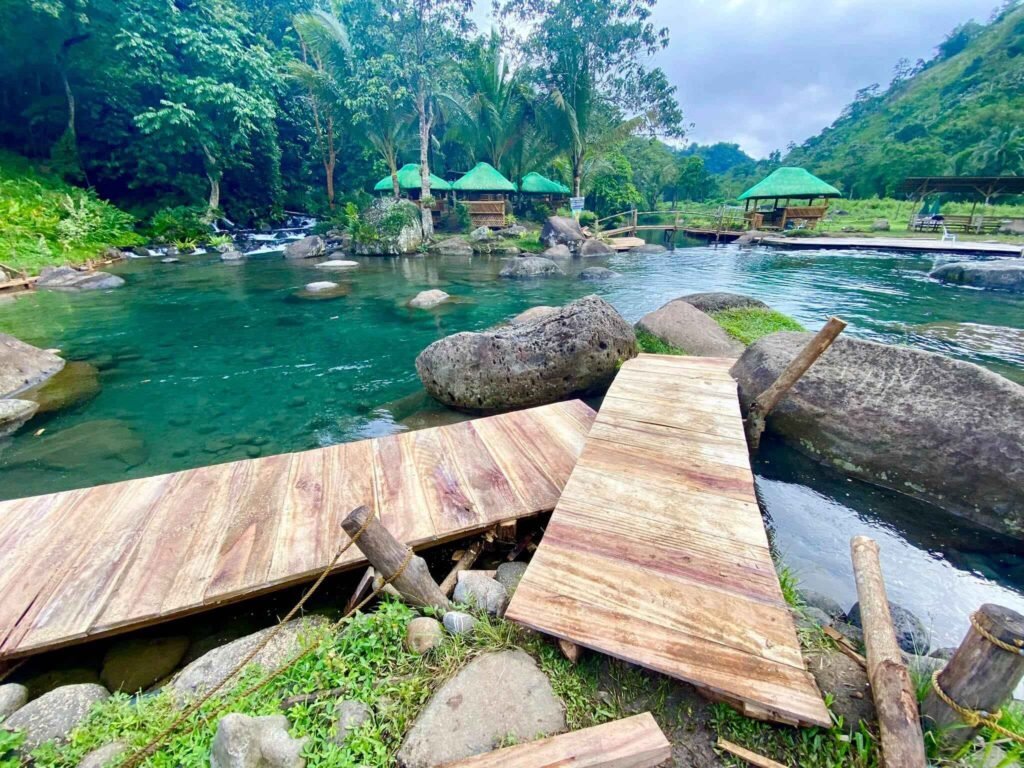
Entrance Fees, Rates, and Policies
One of the most important details to know before your trip is the Sinulom Falls entrance fee. The resort has organized its pricing into simple packages, making it easier for travelers to plan ahead whether they are visiting the infinity spring pool, the cold spring, or both.
Updated Sinulom Falls Rates
Here’s a clear breakdown of the current Sinulom Falls rates:
| Package | Adult | Kids (6–10 yrs) | PWD/Seniors | Notes |
|---|---|---|---|---|
| 2 Areas (Spring Pool + Bolao Cold Spring) | ₱160 | ₱85 | ₱130 | One cottage per area included; 2nd cottage at 50% off |
| Bolao Cold Spring Only | ₱110 | ₱60 | ₱90 | Cottage must match group size |
| Sinulom Infinity Spring Pool Only | ₱110 | ₱60 | ₱90 | Cottage must match group size |
Children under five years old are usually free of charge, but it’s always best to confirm this when booking.
Cottage Policy and Booking Rules
Cottages are mandatory based on group size. For instance, a group of 30 guests must reserve at least three cottages good for ten people each. This ensures that all visitors have a designated space. On weekends and holidays, advance reservations are highly recommended since slots fill quickly. A downpayment—non-refundable in most cases—must be paid at least one day prior to the visit.
Corkage Fees
Bringing your own food and drinks is allowed but comes with an additional charge. The corkage fee in Sinulom Falls is:
₱300 for any type of food
₱300 for any type of drinks
₱500 for lechon (whole roasted pig)
If you’re traveling as a group, these corkage fees can easily add up, so many visitors opt to bring light snacks while trying the limited menu at the on-site restaurant.
Practical Takeaway
From my own trip, I found that booking ahead saved a lot of stress, especially for a large group. Also, if you’re on a budget, it’s wise to split cottage and corkage costs with companions. Knowing these policies in advance will help you enjoy the falls without unexpected expenses.
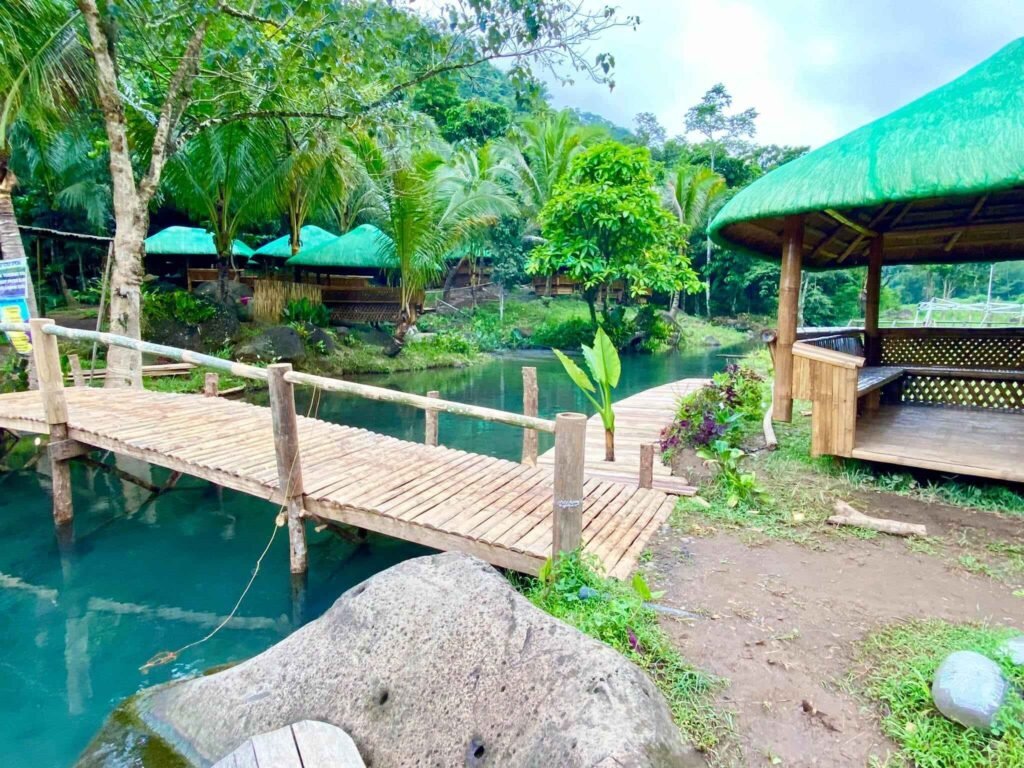
Best Time to Visit Sinulom Falls
Timing is everything when planning a trip to Sinulom Falls Philippines, especially if you want to make the most of your experience. The resort operates daily from 8 AM to 5 PM, which means most visitors plan for a morning or early afternoon arrival to enjoy both the infinity pools and the natural cascades without rushing.
Dry Season vs. Wet Season
The best time to visit Sinulom Falls is during the dry months of November to May. Roads leading to Sitio Impakibel are less muddy, making the trek and habal-habal rides smoother. Water in the pools and Bolao Cold Spring remains clear, and river levels are safer for activities.
The wet season, from June to October, has its perks too. The falls are at their most powerful, creating an even more dramatic curtain effect. However, frequent rains can make roads slippery and the trek to the pools more challenging. If you don’t mind a little mud and want to see the waterfalls in their full force, the rainy season might still be worth it.
Weather and Safety Considerations
Cagayan de Oro’s climate is generally warm and humid, with average highs around 28–30°C (82–86°F). Rainfall is heavier in mid-year months, with July and August often bringing strong downpours. During this time, river activities should be approached with caution, as currents can become unpredictable.
Personal Travel Advice
From my visits, weekdays are far more peaceful compared to weekends when local families and barkadas arrive in big groups. If you want that serene photo of the waterfalls without the crowd, plan for a weekday morning. And whether dry or rainy season, always check the local weather forecast before heading out—it can make or break your trip.
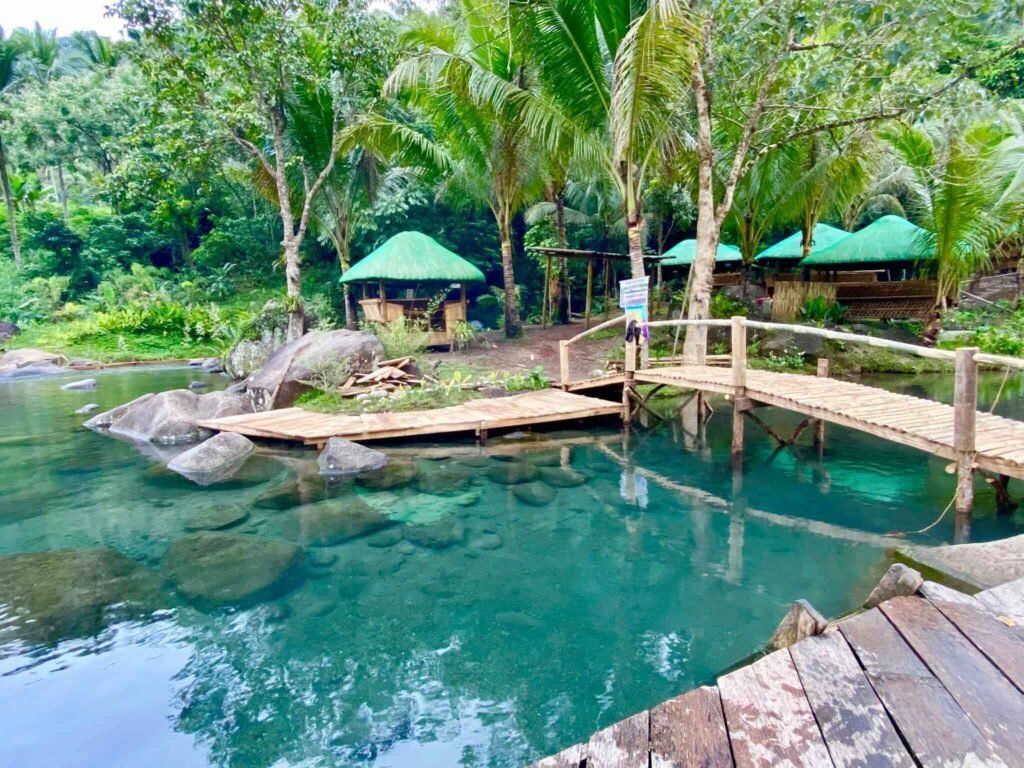
On-Site Experience: Attractions and Activities
A visit to Sinulom is never just about seeing the waterfalls—it’s about immersing yourself in a mix of natural beauty, adventure, and relaxation. From the stunning cascades to the cool spring pools, every corner of the resort offers something worth experiencing. Here’s what to expect once you arrive.
The Main Falls
The highlight of any trip is, of course, the 27 to 28 cascades that make up the majestic wall of Sinulom Falls. From a distance, the streams fall side by side in thin sheets, creating what many describe as a “curtain effect.” The sight alone is breathtaking and explains why Sinulom Falls photos often go viral among travelers in search of new destinations.
Swimming directly under the cascades is not permitted for safety reasons, but that doesn’t diminish the experience. Instead, guests can relax nearby, listen to the thunder of falling water, and take in the misty breeze. For those eager to swim, the resort has thoughtfully built several pools, constantly replenished by fresh spring water. The infinity spring pools are especially popular, designed to mimic the flow of the river while offering safe depths for all ages. One pool even features a diving board, though it’s worth noting that the water is shallow at under two meters—so caution is advised.
Bolao Cold Spring
No trip is complete without visiting the nearby Bolao Cold Spring, also called Balao Cold Spring by locals. Getting there is half the adventure—you’ll cross a large hanging bridge, trek a short trail, and suddenly arrive at a hidden sanctuary of crystal-clear water. The spring is cool, clean, and incredibly refreshing, perfect for families or groups who want a relaxing swim after the trek.
The connection between Sinulom Falls and Bolao Cold Spring makes the experience unique: one offers the spectacle of cascading waterfalls, the other a peaceful, natural swimming pool. The combination is why many visitors plan their trip as a full-day escape.
Activities to Try
The site offers more than just swimming. For a closer look at the falls, you can rent a balsa (bamboo raft) that takes you near the curtain of water—an experience that’s thrilling yet safe when handled by local guides. Photography is another highlight, as the misty atmosphere, lush greenery, and layered cascades make for striking compositions. Trekking around the area also allows you to appreciate the surrounding wildlife and landscape.
Tips for a Fun and Safe Visit
Wear aqua shoes or slippers with good grip for the trek and slippery steps.
Always supervise children in the pools since lifeguards are not consistently on duty.
Bring a waterproof bag to protect your gadgets while crossing the hanging bridge or riding the raft.
If you want unobstructed Sinulom Falls photos, arrive early in the morning before the crowds build up.
With its dramatic waterfalls and serene spring, Sinulom offers the perfect mix of adventure and relaxation, making it a destination that appeals to both thrill-seekers and families looking for a quiet escape.
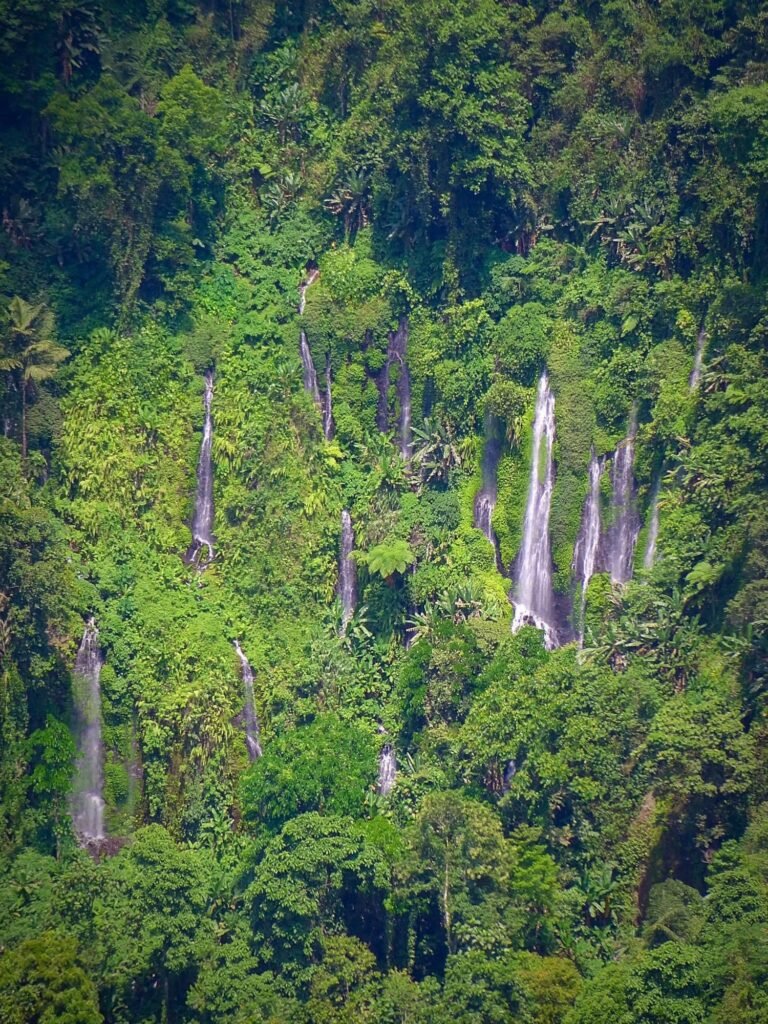
Amenities and Facilities
One of the reasons travelers appreciate Sinulom Falls Philippines is that it offers just enough facilities to make the trip comfortable without taking away from the natural atmosphere. Still, it’s best to know what’s available on-site so you can plan accordingly.
Dining Options
A small restaurant now operates within the resort, serving basic meals and snacks. However, many visitors have noted that the menu can be limited, with some dishes occasionally unavailable. When I visited, I made sure to bring packed food and drinks as a backup—a strategy I recommend to anyone traveling with a group or kids. Do note that corkage fees apply if you’re bringing in outside food or lechon, so factor this into your budget when checking Sinulom Falls rates.
Cottages and Seating
Cottages are required based on group size. These shaded huts provide a place to eat, rest, and store belongings while enjoying the pools and waterfalls. Sizes vary, with smaller cottages for couples or families and larger ones for groups of 10 or more. If you’re visiting with a big barkada, splitting the cost of multiple cottages is the most practical option.
Other Conveniences
The site offers clean toilet facilities, decent parking near Sitio Impakibel, and even a designated tent-pitching area for day visitors who want a more laid-back setup. However, overnight stays are not permitted inside the resort itself. For multi-day trips, the best option is to book accommodations in Cagayan de Oro City, where hotels like Seda Centrio, Limketkai Luxe, or budget-friendly inns provide comfort after a day at the falls.
Overall, the amenities strike a balance between rustic and convenient—enough to make your stay enjoyable while ensuring the raw charm of Sinulom Falls Philippines remains intact.
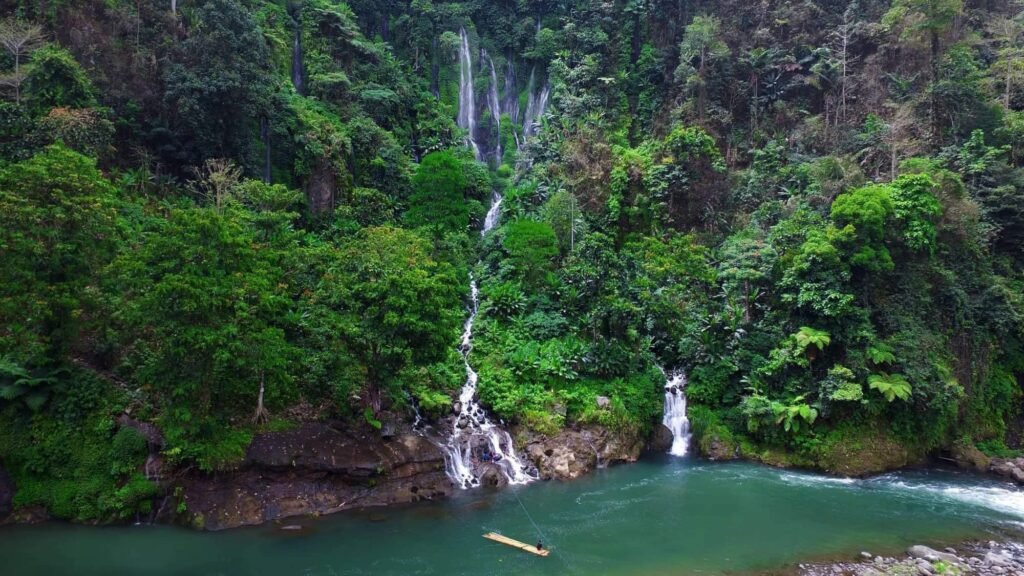
Practical Travel Tips and Hacks
Planning your trip well can make the difference between a smooth adventure and an exhausting one. Here are my tried-and-tested hacks for visiting Sinulom Falls CDO that go beyond the usual guides.
What to Bring
Cash: Most transactions are cash-only, from jeepney fares to cottage rentals. ATMs are not available near Sitio Impakibel.
Packed food and water: The on-site restaurant has a limited menu, so snacks or meals from the city are lifesavers.
Proper footwear: Expect steep paths and slippery stairs. I recommend aqua shoes or sturdy sandals for both trekking and swimming.
Towels and extra clothes: Between trekking, swimming, and crossing the bridge to Bolao Cold Spring, you’ll definitely need a change of clothes.
Backup supplies: For longer day trips, bring a power bank and waterproof bags for gadgets.
Challenges to Expect
The trek from the basketball court to the falls is manageable, but it can be tiring for seniors or those with mobility issues. Road conditions also vary—smooth in the dry season, but muddy and slippery when it rains. Pool safety is another concern, as lifeguards are not always present, so children must be supervised closely. Having a look at a Sinulom Falls map before your trip helps anticipate the terrain and plan your route better.
Budget Tips
If you’re wondering how to go to Sinulom Falls without overspending, the cheapest option is the jeepney plus habal-habal combo. It takes longer than driving, but it keeps costs low. For groups, sharing cottages is the best way to split expenses. To avoid steep corkage fees, I suggest bringing light snacks instead of a full meal spread, then trying the restaurant if something is available.
Personal Hacks
On my visit, downloading an offline map saved me from missing a crucial turn where mobile signal dropped. I also recommend visiting on weekdays when the resort is quieter—you’ll have more space to enjoy the pools and take those picture-perfect shots. Little things like these can turn your trip to Sinulom Falls CDO from good to unforgettable.
Nearby Attractions and Side Trips
While Sinulom is the star of the show, pairing it with nearby spots makes for a fuller itinerary. The most natural complement is the Bolao Cold Spring (or Balao Cold Spring), just a short trek and hanging bridge away. Its crystal-clear waters provide a refreshing counterpart to the waterfalls, making the combination of Sinulom Falls and Bolao Cold Spring a must-do.
For families, thrill-seekers, or those staying longer in the city, Cagayan de Oro offers more. You can spend the next day at Seven Seas Waterpark, famous for its extreme slides, or book a whitewater rafting trip along the Cagayan River. If you’re venturing into Bukidnon, expect rolling hills, coffee farms, and other waterfalls to extend your nature escape.
A suggested itinerary for a weekend would be:
Day 1: Morning at Sinulom Falls → lunch at Bolao Cold Spring → return to CDO city proper.
Day 2: Whitewater rafting or a family day at Seven Seas.
Optional Bukidnon side trip for those with extra time.
This way, your visit becomes more than just a single stop—it transforms into a memorable Northern Mindanao getaway.
Conclusion: Why Sinulom Falls Belongs on Your Bucket List
When you think about what makes a destination memorable, Sinulom Falls Philippines has it all—breathtaking scenery, a fascinating local history, and a balance of accessibility and adventure. The iconic curtain of waterfalls is not only a visual spectacle but also a cultural landmark, rooted in stories of resilience during times of drought. For first-time visitors to Cagayan de Oro, this is one of those places that perfectly blends natural beauty with meaningful heritage.
What makes Sinulom especially appealing is its versatility. Families can enjoy safe swimming in the infinity pools, barkadas can bond over rafting and treks, and nature lovers can savor the surrounding greenery while snapping incredible Sinulom Falls photos. Its location—reachable within an hour from the city proper—makes it an easy day trip, while the nearby Bolao Cold Spring offers a refreshing extension to the experience.
From my own perspective, I’d recommend visiting on a weekday morning. The serenity of having the pools and cascades almost to yourself is incomparable. And while the best time to visit Sinulom Falls is during the dry season for convenience, even the rainy months have their charm, with the cascades flowing at their fullest.
As with any natural attraction, traveling responsibly matters. Follow the resort’s policies, respect the community, and practice Leave No Trace principles. By doing so, you not only protect the site but also ensure future travelers can enjoy the same beauty you did.
Sinulom isn’t just another waterfall—it’s an experience, a story, and a reminder of why Northern Mindanao deserves a spot on every traveler’s bucket list.
Frequently Asked Questions About Sinulom Falls
1. Where is Sinulom Falls located?
Sinulom Falls is located along the boundary of Talakag, Bukidnon, and Cagayan de Oro City. The most accessible entry point is through Barangay Tignapoloan, CDO. Checking a Sinulom Falls map before your trip is highly recommended to avoid confusion along the way.
2. How to go to Sinulom Falls from Cagayan de Oro?
From CDO, you can drive via the CDO–Talakag Road, passing landmarks like Mangalay Bridge and the Jehovah’s Witness Hall before turning to Sitio Impakibel. By commute, take a jeepney or van from Carmen Market to Tignapoloan Crossing, then ride a habal-habal to the basketball court near the jump-off.
3. What is the Sinulom Falls entrance fee?
The Sinulom Falls entrance fee starts at ₱110 per adult for either the infinity spring pool or Bolao Cold Spring. A package covering both areas costs ₱160 per adult. Kids, PWDs, and seniors enjoy discounted rates.
4. What are the Sinulom Falls rates for cottages?
Cottages are required based on group size and are included in most entrance packages. If you need an extra cottage, the second one comes at 50% off.
5. Is outside food allowed at Sinulom Falls?
Yes, you can bring outside food, but expect a corkage fee in Sinulom Falls—₱300 for food, ₱300 for drinks, and ₱500 for lechon. Many visitors choose to bring light snacks and buy simple meals on-site.
6. What is the best time to visit Sinulom Falls?
The best time to visit Sinulom Falls is during the dry season, from November to May, when roads are easier to navigate and pools are clearer. Weekday mornings are ideal if you want to avoid crowds.
7. Can you swim at Sinulom Falls?
Swimming directly under the cascades is not allowed for safety reasons. However, guests can enjoy the infinity pools and the refreshing waters of Bolao Cold Spring.
8. What activities can you do at Sinulom Falls?
Popular activities include swimming, bamboo rafting (balsa) to view the cascades up close, trekking across the hanging bridge, and nature photography.
9. Are overnight stays allowed at Sinulom Falls?
No, overnight stays are not permitted inside the resort. Travelers usually book accommodations in Cagayan de Oro City and enjoy Sinulom Falls as a day trip.
10. Why is Sinulom Falls famous?
Sinulom Falls is famous for its curtain-like wall of 27–28 cascades flowing directly into the Cagayan River, its WWII-linked history, and its pairing with the serene Bolao Cold Spring.

